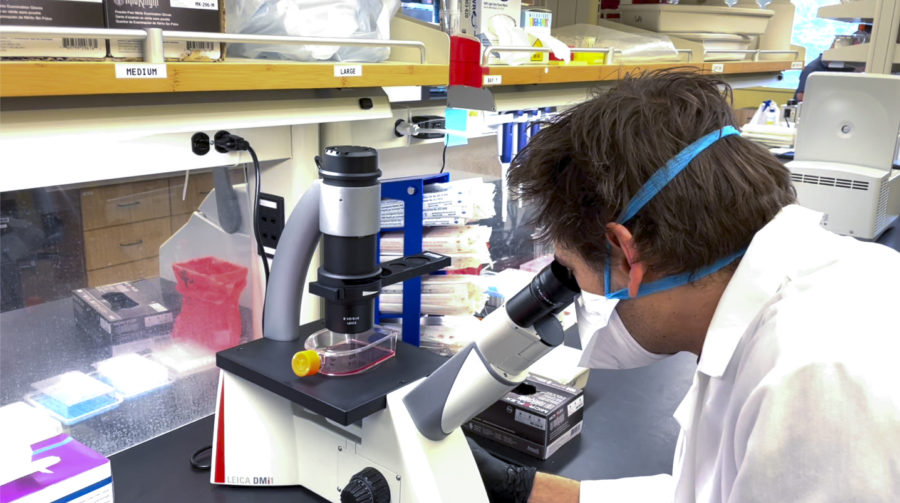Researchers create coronavirus database
Database allows researchers to see similarities between coronaviruses. This could allow one vaccine to work for multiple viruses.
Michael Letko, assistant professor for the Paul G. Allen School for Global Animal Health, works in his lab. He is part of a team that is working to determine which coronaviruses can infect humans.
April 8, 2021
WSU researchers have developed a database to group and organize coronaviruses that may help with pandemic preparedness in the future.
The database contains data about thousands of coronaviruses, many of which were not well known until now. The data was collected by lead researcher Michael Letko, assistant professor for the Paul G. Allen School for Global Animal Health and principal investigator for the Laboratory of Functional Viromics.
While researchers have knowledge about how some coronaviruses behave, like the one that causes COVID-19, there are thousands of coronaviruses. Out of these, scientists do not know which ones can infect humans, Letko said.
Over the past 20 years, several coronaviruses have crossed the species barrier into humans, and new viruses are constantly being discovered, he said. Thousands of coronavirus sequences have been found across diverse animal and geographic regions.
“What we’re doing is going through all of the animal viruses and trying to find out which one seems to have more risk to transmit over the others,” Letko said. “We can then study and learn what types of cells they grow on, learn what type of receptors they use.”
Letko works with synthesized viruses in the lab. Through this, he said he can introduce the viruses to mammalian cells and see how they interact. Using this approach, the researchers can learn about many of these viruses that have only been sequenced up to this point but have never been isolated in the lab before.
“We kind of work backwards from the sequence. We give it to a company, they give us the DNA, we then take the DNA and put it into cells,” Letko said. “The cells then read the DNA and make it into the protein in the bits of the virus for us.”
After a year of working with these viruses and collecting data on their behavior, the researchers are able to put it into a database to find similarities in the sequences. Finding patterns and making matches between these viruses is important because one vaccine could prevent similar viruses from infecting humans in the next epidemic or pandemic, Letko said.
It is fortunate that there was some familiarity with SARS-CoV-2, the virus that causes COVID-19, as it is similar to SARS-CoV-1, which scientists first encountered 20 years ago and have been studying ever since, he said.
“[Twenty years ago] we didn’t even think coronaviruses could cause a severe disease. They gave us the common cold, and that’s all people knew about coronavirus, then SARS-[CoV-]1 came out,” Letko said.
SARS-CoV-1 was much deadlier than scientists thought possible for coronaviruses, he said.
Letko said he has paired up with Shira Broschat, professor of electrical engineering and computer science, who is helping to find bigger trends in the data using computational approaches.
“I think our purpose is to provide the tools for microbiologists and virologists to be able to learn more, to be able to dig deeper, using whatever means,” Broschat said.
Being able to make predictions about virus behavior is key to being prepared for future pandemics, Letko said.
“Before we only knew how a few of those viruses were behaving. After the study, we have a much clearer picture of how many can infect humans,” he said.
Using these computational approaches, they are able to understand not just the remaining percent, but also future viruses that will come out. As new viral sequences are discovered, they can be compared to other viruses that they have already studied, Letko said.
Currently, scientists are waiting for a virus to spill over, at which point in time the virus is studied, he said. This process puts people at a disadvantage because it takes a long time to develop a vaccine against the virus.
“There is this scramble every time the viruses transmit [from animals to humans] to try to figure out anything about it,” Letko said. “We can’t begin to make an animal model, a vaccine, a therapeutic if we can’t get the virus to grow in culture in the laboratory. It’s a real basic snag.”
The idea is to understand these viruses and develop a vaccine before transmission occurs. With the database, the researchers know some of the viruses that are more of a risk than others, he said.
Currently, the team is looking at only one group of viruses because of their prevalence, Broschat said; however, other viruses can cause a pandemic as well.
In the future, they hope to not just explore other coronaviruses but entirely different viruses altogether, Letko said.
“I think the longer-term goal for this is pandemic preparedness. The idea being that we have an understanding for these viruses before they spill over. Trying to know something about the viruses before they have a chance to cause problems,” he said.











